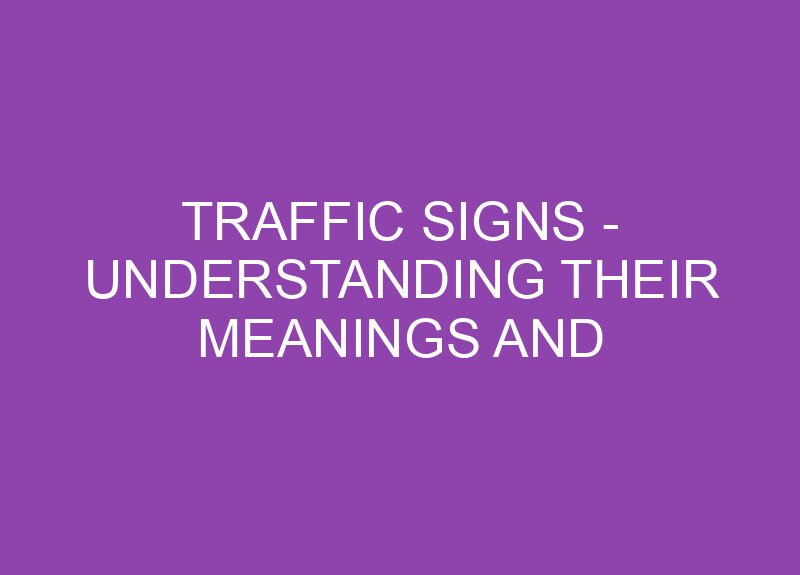Efficient navigation on the roads is contingent on one’s ability to comprehend and interpret the multitude of traffic signs scattered along the thoroughfare. Whether one is a seasoned driver or a novice behind the wheel, being equipped with a comprehensive understanding of these signs is paramount in ensuring safety for all road users. The significance of traffic signs lies not only in their ability to provide order and direction, but they also convey vital information that can mean the difference between life and death. Knowing and obeying these codes of the road is crucial to anticipate and avoid potential hazards. From the stop signs that demand a complete cessation of vehicular motion to the yield signs that necessitate a reduction in speed, each sign holds a distinct meaning that deserves utmost attention. The purpose of this blog post is to delve into the various traffic signs, their meanings, and the imperative role they play in maintaining a harmonious traffic flow where the possibilities of accidents and mishaps are vastly diminished.
Key Takeaways:
- Understanding the meanings of traffic signs is crucial to ensure safe and effective navigation on the road.
- Traffic signs communicate important information about rules, regulations, and potential hazards that drivers need to follow and be aware of.
- Consistent interpretation of traffic signs amongst all road users helps maintain order and prevent accidents.
- Knowing the meanings of traffic signs can improve decision-making and reduce the chances of making dangerous and illegal maneuvers on the road.
- Compliance with traffic signs is legally mandatory and failure to adhere to them may result in fines, penalties, or even accidents.
Meaning of Traffic Signs
Some people may take traffic signs for granted, but they play a crucial role in maintaining order and safety on the road. Understanding the meanings of traffic signs is essential for every driver, as it allows them to navigate the roads confidently and responsibly. Traffic signs are divided into three categories: regulatory signs, warning signs, and guide signs.
Regulatory Signs
Regulatory signs are designed to inform drivers about the laws and regulations they must adhere to while on the road. These signs are typically rectangular and are often accompanied by specific instructions and speed limits. They have a significant impact on how traffic flows and help prevent accidents. Examples of regulatory signs include stop signs, yield signs, and speed limit signs. By obeying these signs, drivers ensure their own safety as well as the safety of others sharing the road with them.
Warning Signs
Warning signs are used to alert drivers about potentially hazardous conditions ahead. These signs feature bold yellow or orange backgrounds with black symbols or text. They are meant to grab a driver’s attention and prompt them to take necessary precautions. Warning signs are especially crucial in areas where there may be unexpected road conditions, such as sharp curves, pedestrian crossings, or animal crossings. By recognizing and acting upon these warning signs, drivers can prevent accidents and navigate the roads safely.
Guide Signs
Guide signs are designed to provide drivers with directional and navigational information. These signs are typically green or blue, and they are crucial in helping drivers find their way to specific destinations. Guide signs include information about highways, exits, distances, and points of interest. While they may not have direct implications on safety, guide signs play a vital role in preventing drivers from getting lost or making sudden last-minute maneuvers, which can be hazardous to themselves and other motorists.
Importance of Traffic Signs on the Road
Nowadays, with a significant increase in the number of vehicles on the road, the importance of traffic signs cannot be overstated. These signs serve as essential tools to regulate and control traffic, ensuring the safety of both drivers and pedestrians. Traffic signs convey crucial information that drivers need to be aware of, including speed limits, road conditions, warnings, and guidance. By obeying these signs, motorists can contribute to a safer, more efficient road environment.
Ensuring Road Safety
When it comes to road safety, traffic signs play a pivotal role. They provide drivers with valuable information that allows them to make informed decisions, reducing the risk of accidents. For instance, signs indicating speed limits prevent drivers from exceeding safe speeds, reducing the likelihood of collisions. Similarly, road signs highlighting hazardous conditions such as sharp curves or slippery surfaces warn drivers to be cautious, preventing accidents that could result in injuries or fatalities. By adhering to these signs, motorists demonstrate responsible driving behavior and protect not only themselves but also other road users.
Avoiding Traffic Violations
To maintain order and enforce traffic laws, traffic signs serve as a reliable means to prevent traffic violations. These signs clearly convey rules, such as stop or yield, which drivers are legally obliged to follow. By observing these signs, motorists can avoid violating traffic regulations, which may result in fines, penalties, or even license suspensions. Additionally, traffic signs indicating restricted areas or parking regulations help prevent unauthorized access and maintain order on the road. By respecting these signs, drivers contribute to a safe and well-regulated traffic system.
Facilitating Smooth Traffic Flow
Traffic signs also play a crucial role in facilitating the smooth flow of traffic. Signs indicating lane directions, turn restrictions, or intersections inform drivers of the correct path to take, minimizing confusion and potential conflicts. By following these signs, drivers can navigate the road network seamlessly, reducing congestion and ensuring a more efficient overall traffic flow. Without these signs, drivers would have to rely solely on their instincts and judgment, leading to chaos and increased chances of accidents. Therefore, traffic signs promote a predictable and orderly driving experience for all road users.
Understanding Specific Traffic Signs
After familiarizing oneself with the general importance and meanings of traffic signs, it becomes crucial to delve into the specifics of each type of sign. The United States Road Symbol Signs, also known as MUTCD (Manual on Uniform Traffic Control Devices), provides a comprehensive guide for these signs. For a complete understanding, one can refer to the United States Road Symbol Signs – MUTCD, which offers a detailed description of each sign’s meaning and design. This valuable resource ensures that drivers have a clear grasp of the information conveyed by specific traffic signs.
Stop Signs
A stop sign is a universal symbol indicating that a driver must bring their vehicle to a complete halt. When approaching this sign, it is crucial to remember that failure to heed it can have devastating consequences. In addition to preventing accidents, stop signs also facilitate the smooth flow of traffic. When a driver obeys a stop sign, they ensure the safety of themselves and others on the road. It is also important to note that disregarding a stop sign can result in hefty fines and legal consequences. Thus, it is paramount for drivers to respect the authority of the stop sign and never compromise their safety or the safety of others.
Speed Limit Signs
Speed limit signs are designed to regulate the maximum speed at which a driver can safely travel on a particular road or highway. These signs serve as crucial reminders for drivers to abide by the specified speed limits. Exceeding the speed limit not only poses a significant risk to the driver but also to pedestrians, cyclists, and other motorists. By adhering to speed limit signs, drivers contribute to a more orderly and safe transportation system. It is essential to remember that these signs are not mere suggestions; they carry legal weight and must be followed at all times. Strict compliance with speed limit signs prevents accidents, reduces the severity of collisions, and ultimately saves lives.
Yield Signs
Yield signs play a pivotal role in facilitating the smooth flow of traffic at various road junctions. When encountering a yield sign, drivers must yield the right-of-way to vehicles or pedestrians approaching from other directions. Yielding allows for a safer merging or turning maneuver and helps prevent potentially dangerous conflicts. By respecting yield signs, drivers demonstrate their responsibility and consideration towards others on the road. Failure to yield can lead to avoidable accidents, causing harm to both the driver and others involved. Always remember, yielding is not a sign of weakness, but rather an act of prudence and respect for fellow road users.
No Parking Signs
No parking signs indicate areas where vehicles are prohibited from parking. These signs are typically placed in locations where parking may obstruct traffic or pose risks to pedestrians or emergency vehicles. It is essential for drivers to adhere to these signs to maintain the overall safety and efficiency of the roadways. By not parking in designated no parking zones, drivers contribute to the smooth flow of traffic, avoid unnecessary congestion, and ensure the accessibility of public spaces. Ignoring no parking signs can result in fines, towing, or inconvenience to others. Thus, it is imperative to heed these signs and park only in designated areas.
One-Way Signs
One-way signs indicate that traffic is allowed to flow in only one direction on a particular road or street. These signs exist to prevent head-on collisions, guide traffic efficiently, and enhance overall safety. It is crucial for drivers to follow one-way signs diligently. Driving in the wrong direction on a one-way road not only endangers oneself but also poses a grave risk to other road users. By adhering to one-way signs, drivers contribute to the harmonious flow of traffic and reduce the likelihood of accidents. Always respect these signs and safely navigate the designated traffic patterns.

Conclusion
Conclusively, understanding the meanings and importance of traffic signs is essential for all road users. By familiarizing oneself with these signs, he or she can navigate the road safely and efficiently, reducing the risk of accidents and ensuring a smooth flow of traffic. Traffic signs serve as a universal language that enables drivers, pedestrians, and cyclists to communicate and understand each other’s intentions on the road. It is therefore imperative that everyone takes the time to learn and obey these signs, as they play a crucial role in maintaining order and safety on our streets and highways.
FAQ
Q: What is the purpose of traffic signs?
A: Traffic signs serve as visual communication tools that convey important information to drivers, pedestrians, and cyclists on the road. They help regulate traffic, provide warnings, give directions, and ensure the safety and efficiency of road users.
Q: How are traffic signs categorized?
A: Traffic signs are categorized into three main types: regulatory signs, warning signs, and guide signs. Regulatory signs include stop signs, speed limit signs, and yield signs. Warning signs alert drivers of potential hazards ahead, such as sharp turns or pedestrian crossings. Guide signs provide information about destinations, distances, and services available on the road.
Q: What is the importance of understanding traffic signs?
A: Understanding traffic signs is crucial for both experienced and new drivers. It helps ensure compliance with traffic laws, promotes road safety, and reduces the risk of accidents. Properly interpreting traffic signs allows drivers to make informed decisions, react to changes in road conditions, and navigate routes effectively.
Q: How can I learn the meanings of different traffic signs?
A: Learning the meanings of traffic signs requires studying their shapes, colors, symbols, and textual messages. Referencing a driver’s manual or a comprehensive guidebook on traffic signs can provide detailed information. Additionally, taking driver education courses or practice quizzes online can help reinforce your understanding and recognition of traffic signs.
Q: What should I do if I encounter a traffic sign I am unsure about?
A: If you encounter a traffic sign you are unsure about, it is important to proceed with caution. Reduce your speed, observe your surroundings, and try to decipher the sign based on its shape, color, and symbols. If necessary, safely pull over to consult a map or use a navigation app for clarification. Always prioritize safety and adhere to any general rules of the road until you can confirm the meaning of the sign.









